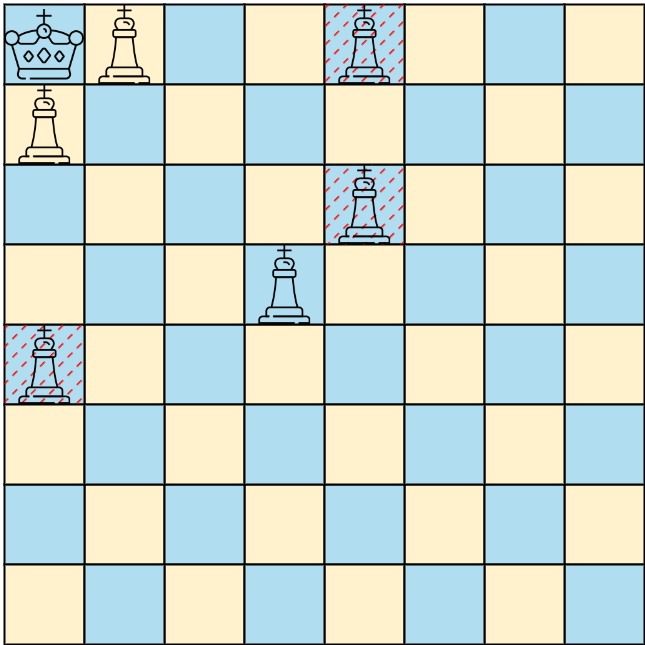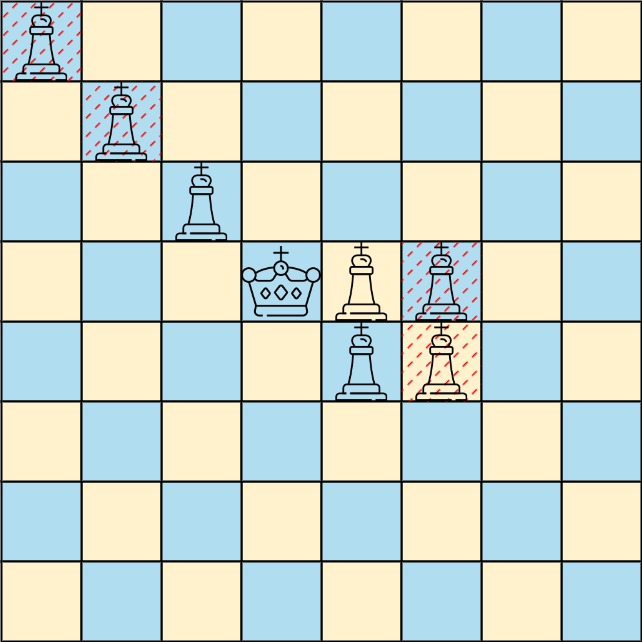- {x}
- Two Sum BSTs
- Stepping Numbers
- Valid Palindrome III
- Minimum Cost to Move Chips to The Same Position
- Longest Arithmetic Subsequence of Given Difference
- Path with Maximum Gold
- Count Vowels Permutation
- Split a String in Balanced Strings
- Queens That Can Attack the King
- Dice Roll Simulation
- Maximum Equal Frequency
- Report Contiguous Dates
- The Dining Philosophers
- Airplane Seat Assignment Probability
- Missing Number In Arithmetic Progression
- Meeting Scheduler
- Toss Strange Coins
- Read More...

Queens That Can Attack the King
On a 0-indexed 8 x 8 chessboard, there can be multiple black queens and one white king.
You are given a 2D integer array queens where queens[i] = [xQueeni, yQueeni] represents the position of the ith black queen on the chessboard. You are also given an integer array king of length 2 where king = [xKing, yKing] represents the position of the white king.
Return the coordinates of the black queens that can directly attack the king. You may return the answer in any order.
Example 1:

Input: queens = [[0,1],[1,0],[4,0],[0,4],[3,3],[2,4]], king = [0,0] Output: [[0,1],[1,0],[3,3]] Explanation: The diagram above shows the three queens that can directly attack the king and the three queens that cannot attack the king (i.e., marked with red dashes).
Example 2:

Input: queens = [[0,0],[1,1],[2,2],[3,4],[3,5],[4,4],[4,5]], king = [3,3] Output: [[2,2],[3,4],[4,4]] Explanation: The diagram above shows the three queens that can directly attack the king and the three queens that cannot attack the king (i.e., marked with red dashes).
Constraints:
1 <= queens.length < 64queens[i].length == king.length == 20 <= xQueeni, yQueeni, xKing, yKing < 8- All the given positions are unique.
Solution Explanation: Queens That Can Attack the King
This problem involves finding all queens on a chessboard that can attack a white king. The solution uses a direct search approach, iterating through all eight possible directions from the king's position and checking for the presence of a queen in each direction.
Approach:
-
Data Structure: A boolean 2D array
s(or a set in Python) is used to efficiently represent the chessboard.s[i][j]istrueif a queen is at position (i, j), andfalseotherwise. This allows for quick lookups of queen positions. -
Direction Iteration: The code systematically checks eight directions from the king's position: up, down, left, right, and four diagonal directions. This is accomplished using nested loops with
aandbiterating from -1 to 1 (excludinga = b = 0). -
Linear Search in Each Direction: For each direction, a
whileloop moves along that direction from the king's position. It continues until it either finds a queen (s[x][y] == true), reaches the edge of the board, or encounters an empty square. -
Queen Detection and Result: If a queen is found (
s[x][y] == true), its coordinates[x, y]are added to theanslist (or equivalent data structure) which holds the attacking queens. The inner loop then breaks because the direction is exhausted. -
Return Value: Finally, the list
anscontaining the coordinates of the queens that can attack the king is returned.
Time Complexity: O(n), where n is the size of the board (8x8 in this case). The worst-case scenario involves checking all squares along each of the eight directions, giving a total of at most 8 * 7 = 56 steps. The time complexity remains constant regardless of the number of queens.
Space Complexity: O(1). The space used is dominated by the boolean array s which is of fixed size (64 booleans). The size of the ans array is at most 8 (when all 8 directions have attacking queens). Thus, the space usage is constant and independent of the input size.
Code Explanation (Python):
class Solution:
def queensAttacktheKing(
self, queens: List[List[int]], king: List[int]
) -> List[List[int]]:
n = 8
s = {(i, j) for i, j in queens} # Efficient set representation
ans = []
for a in range(-1, 2):
for b in range(-1, 2):
if a or b: # Skip the (0, 0) case (king's position)
x, y = king
while 0 <= x + a < n and 0 <= y + b < n:
x, y = x + a, y + b
if (x, y) in s:
ans.append([x, y])
break # Found a queen, stop searching this direction
return ans
The other language implementations follow the same logic, differing only in syntax and data structures. For example, Java uses a 2D boolean array, while C++ uses a boolean 2D array, Go uses a 2D boolean array and TypeScript utilizes a nested boolean array. The core algorithm remains consistent across all provided languages.